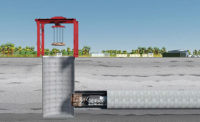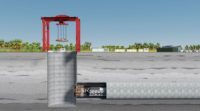Canadian energy giant Enbridge has named a joint venture partnership between two tunneling companies, Barnard Construction Co. and Civil and Building North America, to lead construction of the Great Lakes Tunnel in the Straits of Mackinac.
The new tunnel will enclose the existing 4-mile-long, 71-year-old Line 5 pipeline that carries gas, oil and fiber lines along the lakebed, under the straits, between Lake Michigan and Lake Huron.
Barnard, based in Bozeman, Mont., and CBNA, headquartered in Miami, Fla., will work with Enbridge to build the tunnel that is pending environmental approval.
“We are waiting on a permit from the U.S. Army Corps. The Corps has said it will have a decision in early 2026,” says Enbridge spokesperson Ryan Duffy.
Estimated in 2018 as a $500-million project, the tunnel doesn’t yet have a revised cost, Duffy says. In 2019, Michigan Attorney General Dana Nessel (D) called the 2018 legislation enabling the tunnel project “unconstitutional” and filed a lawsuit to shut down Line 5 and stop the tunnel,
A Michigan Court of Claims judge ruled in 2023 that the company can build the tunnel and that the passage of the bill to allow its construction, under the administration of former Gov. Rick Snyder (R), was, indeed, constitutional.
Controversy heightened in 2020 when Enbridge, as regular part of a maintenance and inspection program, discovered and reported that an anchor support on the east leg of the twin pipeline had been damaged, but had not caused a leak.
Both the state Dept. of Environment, Great Lakes and Energy and Michigan Public Service Commission have approved the tunnel.
Combined, Barnard and CBNA, which will be known as Mackinac Straits Partners, have built more than 100 tunnels in 15 countries equaling more than 372 miles of tunnel. A number of those projects involved geologic conditions similar to those that exist in the straits, according to Enbridge.
Brian O'Mara, geological engineer and director of industrial and power solutions at the Detroit office of Lone Wolf Resources, an engineering firm that specializes in environmental remediation, testified on behalf of one the Native American Tribes challenging the project to the Michigan Public Service Commission and questioned its safety.
"Tunneling beneath open water—people have been trying it for hundreds of years—is the most complicated, most challenging, difficult thing we can do on earth," he said. "It may sound simple but it is not. There is no other project on the planet where they have done something like this.”
Enbridge countered to the commission that it could be done safely and that tunnels below lakes have been constructed safely before, including the tunnels that carry drinking water below Lake Michigan to Chicago via its Harrison and Dever cribs, build in 1867.
Preconstruction on the tunnel started in 2019 when samples of sediment and rock were studied to learn about the geology of the straits and to inform the tunnel’s design, Enbridge said.
The project will entail construction of an entry point for the 500-ft-long tunnel boring machine on the south side of the straits where there will also be a slurry separation plant to separate rock, clay, pebbles and water that will be pumped out of the tunnel. Once separated, the water will be reused in the tunneling process. The TBM, with thousands of components, will take three to four months to assemble.
The TBM will be required to excavate through limestone, rock and shale as it lifts 1-ft segments of reinforced concrete liner into place and seals them. The machine will be required move up to 40 ft per day, five days a week. A vertical shaft is planned to be constructed on the north side of the straits for retrieving and dismantling the TBM.
During construction, saturation divers will need to perform regular inspections and maintenance. Divers will be required to live in pressure chambers on the water's surface for weeks at a time and the plan is to transport them down in a pressurized habitat at the head of the tunnel boring machine to do their work.
Duffy says Enbridge is prepared to begin construction as soon as possible following the receipt of the U.S. Army Corps of Engineers permit. It expects the project to start in 2026 and take about two years to be completed.
Financed solely by Enbridge, the tunnel, when completed, will be owned and operated by the Mackinac Straits Corridor Authority, a new state authority created by the 2018 legislation.




